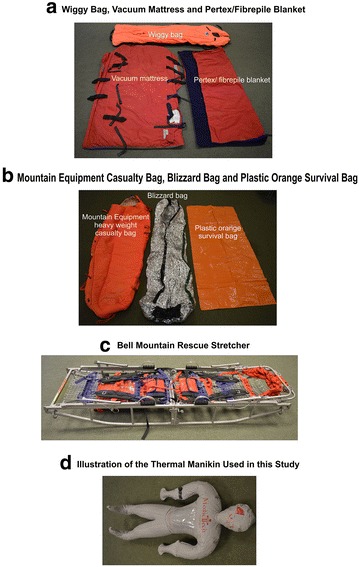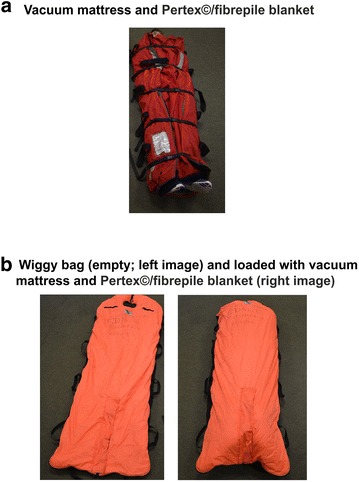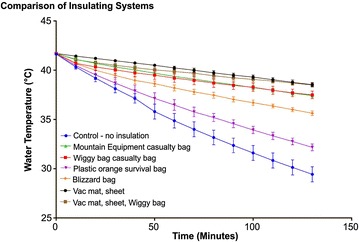Christopher Press, Christopher Duffy, Jonathan Williams, Ben Cooper, Neil Chapman
下载PDF
{"title":"Measurements of rates of cooling of a manikin insulated with different mountain rescue casualty bags.","authors":"Christopher Press, Christopher Duffy, Jonathan Williams, Ben Cooper, Neil Chapman","doi":"10.1186/s13728-017-0055-7","DOIUrl":null,"url":null,"abstract":"<p><strong>Background: </strong>Accidental hypothermia is common in those who sustain injuries in remote environments. This is unpleasant and associated with adverse effects on subsequent patient outcomes. To minimise further heat loss, a range of insulating systems are available to mountain rescue teams although the most effective and cost-efficient have yet to be determined.</p><p><strong>Methods: </strong>Under ambient, still, dry, air conditions, a thermal manikin was filled with water at a temperature of 42 °C and then placed into a given insulation system. Water temperature was then continuously observed via an in-dwelling temperature sensor linked to a PROPAQ 100 series monitor and recorded every 10 min for 130 min. This method was repeated for each insulating package.</p><p><strong>Results: </strong>The vacuum mattress/Pertex©/fibrepile blanket system, either on its own or coupled with the Wiggy bag, was the most efficient with water temperatures only decreasing by 3.2 °C over 130 min. This was followed by the heavy-weight casualty bags without the vacuum mattress/Pertex©/fibrepile blanket system, decreasing by 4.2-4.3 °C. With the Blizzard bag, a decline in water temperature of 5.4 °C was seen over the study duration while a decrease of 9.5 °C was noted when the plastic survival bag was employed.</p><p><strong>Conclusions: </strong>Under the still-air conditions of the study, the vacuum mattress/Pertex©/fibrepile blanket was seen to offer comparable insulation effectiveness compared to be both heavy-weight casualty bags. In turn, these three systems appeared more efficient at insulating the manikin than the Blizzard bag or plastic survival bag.</p>","PeriodicalId":89765,"journal":{"name":"Extreme physiology & medicine","volume":"6 ","pages":"1"},"PeriodicalIF":0.0000,"publicationDate":"2017-04-20","publicationTypes":"Journal Article","fieldsOfStudy":null,"isOpenAccess":false,"openAccessPdf":"https://sci-hub-pdf.com/10.1186/s13728-017-0055-7","citationCount":"5","resultStr":null,"platform":"Semanticscholar","paperid":null,"PeriodicalName":"Extreme physiology & medicine","FirstCategoryId":"1085","ListUrlMain":"https://doi.org/10.1186/s13728-017-0055-7","RegionNum":0,"RegionCategory":null,"ArticlePicture":[],"TitleCN":null,"AbstractTextCN":null,"PMCID":null,"EPubDate":"2017/1/1 0:00:00","PubModel":"eCollection","JCR":"","JCRName":"","Score":null,"Total":0}
引用次数: 5
引用
批量引用
Abstract
Background: Accidental hypothermia is common in those who sustain injuries in remote environments. This is unpleasant and associated with adverse effects on subsequent patient outcomes. To minimise further heat loss, a range of insulating systems are available to mountain rescue teams although the most effective and cost-efficient have yet to be determined.
Methods: Under ambient, still, dry, air conditions, a thermal manikin was filled with water at a temperature of 42 °C and then placed into a given insulation system. Water temperature was then continuously observed via an in-dwelling temperature sensor linked to a PROPAQ 100 series monitor and recorded every 10 min for 130 min. This method was repeated for each insulating package.
Results: The vacuum mattress/Pertex©/fibrepile blanket system, either on its own or coupled with the Wiggy bag, was the most efficient with water temperatures only decreasing by 3.2 °C over 130 min. This was followed by the heavy-weight casualty bags without the vacuum mattress/Pertex©/fibrepile blanket system, decreasing by 4.2-4.3 °C. With the Blizzard bag, a decline in water temperature of 5.4 °C was seen over the study duration while a decrease of 9.5 °C was noted when the plastic survival bag was employed.
Conclusions: Under the still-air conditions of the study, the vacuum mattress/Pertex©/fibrepile blanket was seen to offer comparable insulation effectiveness compared to be both heavy-weight casualty bags. In turn, these three systems appeared more efficient at insulating the manikin than the Blizzard bag or plastic survival bag.
用不同的山地救援伤员袋保温的人体模型的冷却速率测量。
背景:意外低温在偏远环境中受伤的患者中很常见。这是令人不快的,并与后续患者预后的不良影响有关。为了尽量减少进一步的热量损失,山地救援队可以使用一系列隔热系统,尽管最有效和最经济的系统尚未确定。方法:在环境、静止、干燥、空气条件下,将一个热人体模型装满42°C的水,然后放入给定的绝缘系统中。然后通过连接到PROPAQ 100系列监视器的内置温度传感器连续观察水温,每10分钟记录一次,持续130分钟。每个绝缘包装重复此方法。结果:真空床垫/Pertex©/fibrepile毯子系统单独使用或与Wiggy袋结合使用时,水温在130分钟内仅降低3.2°C,效率最高。其次是不使用真空床垫/Pertex©/fibrepile毯子系统的重型伤员袋,水温降低4.2-4.3°C。在研究期间,使用暴雪袋的水温下降了5.4°C,而使用塑料生存袋的水温下降了9.5°C。结论:在研究的静止空气条件下,真空床垫/Pertex©/纤维堆毯与两种重型伤员袋相比,可以提供相当的隔热效果。反过来,这三种系统似乎比暴雪袋或塑料生存袋更有效地隔离人体。
本文章由计算机程序翻译,如有差异,请以英文原文为准。




 求助内容:
求助内容: 应助结果提醒方式:
应助结果提醒方式:


